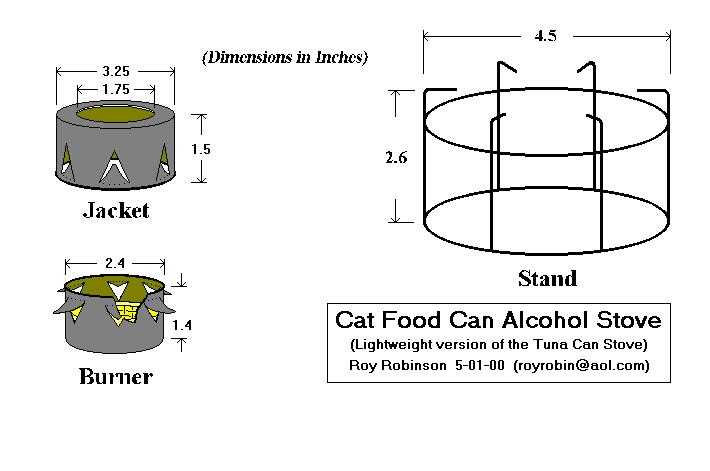THE CAT FOOD CAN ALCOHOL STOVE
(A Lightweight version of the Tuna Can Stove)
Roy L. "TrailDad" Robinson
The original tuna can stove hiked with me along the Pacific Crest Trail last year (1999) for over 1500 miles, from Donner Pass near Lake Tahoe to Manning Park, British Columbia. It served me well for almost three months, heating water for soup, cooking dinners and warming the occasional morning cocoa without any problems or failures.
This new, lightweight version of my stove was introduced at ADZPCTKOP2, (i.e., the Second Annual Day Zero Pacific Crest Trail Kick Off Party,) at Lake Morena. It wasn’t the prettiest or the lightest stove there but it did boil one cup of water the fastest – in 2 minutes, 24 seconds. Like the original tuna can alcohol stove, it will bring two cups of water to a boil in about 5 minutes, has no moving parts and will fit inside your cook pot. Unlike the original, the new cat food can stove weighs just 1.6 ounces including the stand and windscreen. To save space, let’s just call it the Cat Stove.
MATERIALS:
The drawing above shows the three parts of the stove. The Burner is made from a 3 oz. cat food can and the Air Jacket is a 5.5 oz. cat food can. 2 x 3 inch welded wire screen is used to make the Stand. The aluminum foil windscreen is not shown in the drawing.
PHOTO 1. Required Materials.
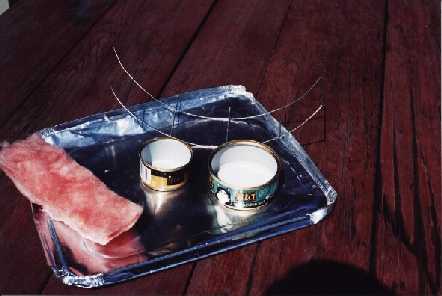 |
The raw materials needed to make the stove are shown in Photo No. 1. These are:
- Two cat food cans, one 3 oz. and one 5.5 oz.
- Fiberglass insulation.
- 2 x 3 inch welded wire for stand.
- Heavy aluminum foil for windscreen.
|
MAKING THE BURNER:
PHOTO 2. Air Jacket (left) and Burner.
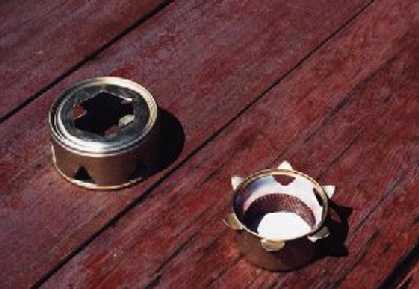 |
Using a small church key-type can opener, cut six tabs from the inside out around the sides of the smaller can. Cut some fiberglass material and place it around the inside of the can, holding it in place temporarily with a coil of metal window screen. The fiberglass should come no higher than the bottom of the tab holes (about 1 inch above the bottom of the can), and should be about 0.2 inch thick. See Photo No. 2. |
The window screen can be removed after the stove has been used once or twice. If you prefer, you can burn a couple tablespoons of fuel in the burner now, and then remove the screen.
MAKING THE AIR JACKET:
Cut a 1.75 inch diameter hole in the bottom of the larger can and six tabs from the outside in around the edge. I cut a hexagonal hole in my stoves for no reason other than it’s easy. You can see this in Photo No. 2. Use a large church key to cut the tabs if you have one.
ASSEMBLING THE BURNER AND AIR JACKET:
PHOTO 3. Wind Screen and Stand (left), with the Burner and Air Jacket in Position to Assemble.
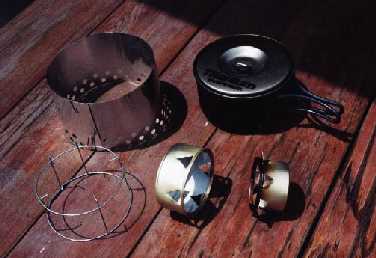 |
Straighten the tabs so they point directly toward the center of the can and cut the sharp points off the tabs, no more than 1/16 inch. This will help the tabs hold the inner can in place more firmly when they are assembled.
Now, aligning the tabs on the two cans so they will miss each other, push the burner into the air jacket. Adjust the tabs, if necessary, so the burner is centered inside the jacket. The jacket should be pushed down onto the burner until it and the burner are both resting on the work surface. |
MAKING THE STAND AND WIND SCREEN:
The completed stand and windscreen are shown in Photo No. 3. Approximate dimensions for the stand are given in the drawing on page 1. Bend the wire into a diameter that will fit inside your cook pot and a height that will hold the pot about 1 inch above the burner/air jacket.
The windscreen is critical for proper operation of this or any alcohol stove. Cut the windscreen out of heavy aluminum foil. An oven liner or disposable baking pan is a good source of foil. Cut a rectangle that is wide enough so the pot handle will just clear the windscreen, and long enough so it will encircle the pot with about ¼ to ½ inch of clearance. Mine is 3.75 x 22 inches. The screen must come up around the sides of the pot. If your pot handle won’t allow that, cut a notch out of the screen for the handle.
Punch two rows of holes around the bottom edge of the windscreen. A paper punch works well. I use a ¼ inch canvas grommet punch. Bend the foil into a cylinder and hold the ends together with paper clips. (Carry a couple extra paper clips. If you drop one in camp, it’s hard to find.)
The windscreen can be rolled around your fuel bottle when not in use. I keep the bottle and windscreen rolled inside my sleeping pad while on the trail.
OPERATION:
PHOTO 4. The Cat Stove in Operation.
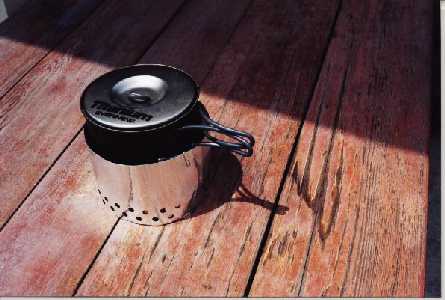 |
Using my 0.9 liter pot, the stove will bring one pint of cold water to a boil in about five minutes. Use no more than 2 or 3 tablespoons of alcohol, and plan to let it burn out. With the pot on the stove, there will be no visible yellow in the flame. At night, you can see a nice blue glow around the pot. |
Caution: In bright daylight, you may not be certain the stove is lit even when it’s at full heat. Be careful you don’t find out the hard way by getting part of yourself or any burnable material too close to the stove while it is burning.
FINALLY:
This is an ALCOHOL stove. DON’T USE WHITE GAS, COLEMAN FUEL OR ANY OTHER GASOLINE FUELS IN THIS STOVE! |
